Welcome! If it’s your first time here, please‘LIKE‘ LashWorldTour, if you enjoy your read here. Thank you!—–>>
BALINESE HINDU CEREMONIES
When visiting Bali, you’ll quickly notice that traditional Balinese Hindu ceremonies are an important, integral part of daily life on the ‘Island of the Gods.’ Such traditions are partly what makes Bali so unique and charming. Regularly mingling with locals dressed in traditional ceremonial clothing, carrying baskets of fruit/flower offerings, going off to temples or beaches or friends’ homes to attend the seemingly never-ending series of ceremonies are vivid experiences visitors remember fondly.
What visitors won’t recognize so easily is that this slew of ceremonies affects Balinese life in other unexpected ways. For example, Balinese use large amounts of their income for the frequent and expensive decorations, offerings, special clothing and feasts required for such ceremonies. The rituals and preparations also consume an astounding amount of their time. In addition, Balinese employees are repeatedly skipping out on work, taking hours- or days- off, which makes businesses run much less smoothly than in the western world.
The Hindu ceremonies themselves are quite complicated and frequent. The Balinese calendar reveals that during each month of the year 8-15 days are considered special Hindu days of one sort or the other. That means every 2-4 days of the Balinese’ lives is a religious ceremony! As for complexity, several detailed books have been written on the subject. As a brief overview:
The Balinese recognize 5 categories of ceremonies:
1. Ceremonies for the Gods. “Dewa Yodnya”
2. Ceremonies for humans’ important life events. “Mansa Yodnya”
3. Ceremonies for priests. “Resi Yodnya”
4. Ceremonies for ancestors. “Pitra Yodnya”
5. Ceremonies for devils. “Bita Yodnya”
Ceremonies for Gods and humans are by far the most abundant and lavish. It’s primarily these 2 types of ceremonies, along with daily Hindu offerings, that keep the Balinese perpetually preparing for and attending ceremonies. Following are details on these 2 major category of ceremonies.
1. Ceremonies for Gods
These include monthly full moon ‘Purnama’ and new moon ‘Tilem’ ceremonies, annual ‘Nyepi’ (‘Silence Day’), several bi-annual ceremonies including ‘Galungan,’ ‘Kuningan’ and ‘Tumpaek Wayan’ as well as heaps of smaller ceremonies. All God-praising ceremonies take place at Balinese temples, which are found abundantly throughout Bali. For 1-3 days before each ceremony the Balinese are busy bustling around getting ready: making decorations and elaborate offerings, preparing clothes and organizing transportation if necessary.
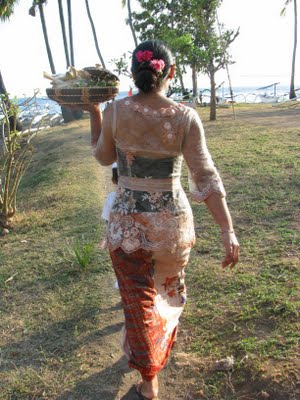 local woman carrying offerings to local temple |
| local Balinese woman carrying offerings to temple |
On the ceremony day everyone dresses up, carries offerings to temple, socialize, then return home. For more important ceremonies people make excursions to further, bigger temples. On certain days throughout the year visitors to Bali can literally witness thousands of Balinese dressed in ceremonial clothing, walking down the streets, stopping traffic as they go, heading to the particularly appointed temple! It’s much like a parade.
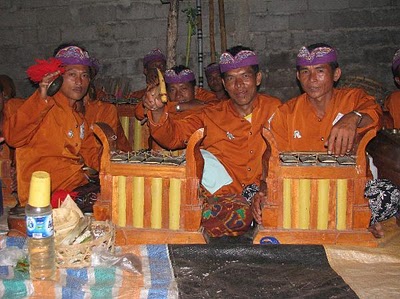 Balinese gamelan orchestra at ceremony |
Are you wondering what happens at such temple ceremonies? I’ve been lucky enough to attend a few. Here’s what I’ve experienced. First, not surprisingly, everyone prays to the Gods. Prayers are lead by temple priests dressed entirely in white. Generally the masses simply sit on the ground during the prayers. At appointed times priests wander around in the crowds blessing each person with ‘holy water,’ flowers, and chants. Depending on the particular ceremony, a live gamelan orchestra may be playing (traditional Balinese percussion orchestras).
Traditional dancing and theatrical is performed. In between prayers and performances, everyone simply sits around chatting. It’s like a big social gathering. Everyone has brought offerings of fruit, flowers, and other foods. The size of their offerings depends on the particular ceremony and the wealth of the family. Ceremonies can last a short time or all night. Throughout the event, people are coming and going, staying as long or as short a time as they like.
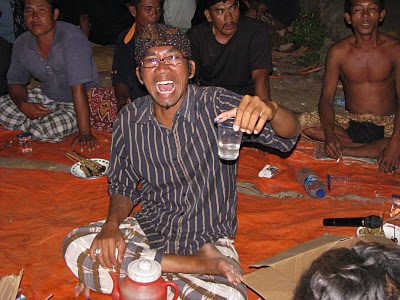 Balinese participating in local ceremony |
2. Ceremonies marking important human events
These include the usual abundant weddings, funerals and cremations. In addition are several ceremonies marking special dates for babies and the famous Balinese coming of age ceremony, marked by teeth filing.
Quite different from Christian practices, Balinese celebrate numerous occasions during their babies’ development. At each ceremony the parents invite guests to their home to celebrate with food and drink. Guests bring presents. The number of guests and size of the ceremony depends on the wealth of the family, varying from simply a few close relatives and friends all the way to inviting an entire town!
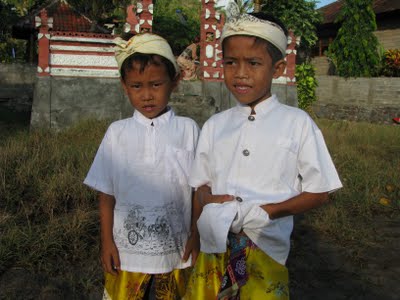 young Balinese boys dressed for temple ceremony |
The first baby ceremony called “maegadong gadongaan” happens before the baby is even born! When the fetus is 7 months old, the parents hold a ceremony to pray for the baby’s health. This particular ceremony is usually done only for the woman’s first baby, though the parents can chose to have it for all their babies if they have the money and desire. In any event, after the baby has been born and is 12 days old, there’s a ceremony “Kapus Pungsed” to cut the umbilical cord. Up until this day, from the time of birth, the parents and baby are not supposed to leave their house! Although nowadays they’re permitted to leave to get medicine for the baby if needed. Next, at 42 days-old there’s “Pitu Bulanmin” ceremony.
The next ‘baby ceremony’ is at 3-months of age. It’s called “Telu Bulanaan” Until this day, babies are not permitted to touch the ground! For this ceremony, parents adorn the baby with some kind of jewelry such as earrings, bracelets, necklaces. So adorned, the child touches the ground for the first time in her/ his life. Finally at 6 months there is “Autonan” during which the baby’s hair is completely cut off. The Balinese believe the baby’s first hair is dirty. After this ceremony the child is believed to be clean. This Autonan, 6-month ceremony, is equivalent to our western annual birthday. For the rest of the person’s life he/she will celebrate his/her 6-month ‘birthday’.
Once a child reaches sexual maturity he/she is able to celebrate his/her coming of age by a teeth-filing ceremony. There’s no set age for this ceremony. Villages/ families tend to do this as a group event, so several teens, often of varying ages, will undergo this ritual together. After the teeth filing ceremony, the Balinese basically mark the same human life events as westerners: weddings and funerals, plus the cremation ceremony.
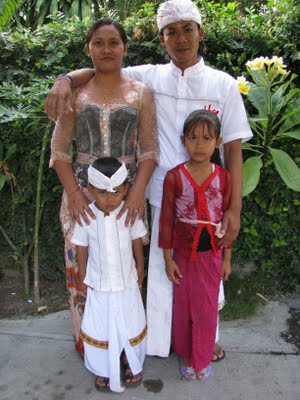 Balinese en route to ceremony |
So as you can see, between the bi-monthly, bi-annual, and annual temple ceremonies for Gods, the plethora of human life-event ceremonies, and the less frequent but still important ceremonies for priests, ancestors and devils, it’s quite evident why the Balinese are seemingly always preparing for and attending ceremonies! Balinese Hinduism truly is an integral part of daily life here. And as a visitor to Bali you cannot help but observe such ceremonies all around you. This is partly what makes Bali so unique and so charming.






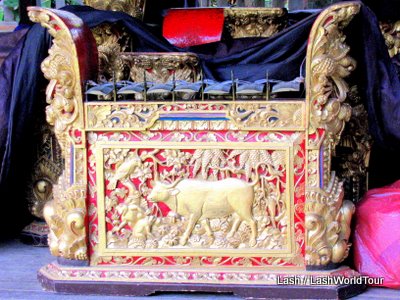
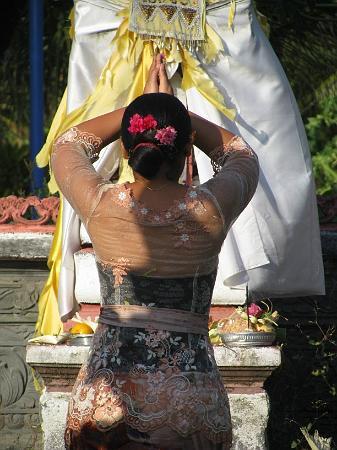



 Hi! I'm Lash, an American nomadic world traveler who's been traveling solo since 1998. I’m passionate about traveling the world nomadically and then sharing it all with you. I hope to inspire you to travel the world, to entertain you with tales from the road, and to help you reach your travel dreams. Welcome!
Hi! I'm Lash, an American nomadic world traveler who's been traveling solo since 1998. I’m passionate about traveling the world nomadically and then sharing it all with you. I hope to inspire you to travel the world, to entertain you with tales from the road, and to help you reach your travel dreams. Welcome! 




12 pings
Skip to comment form ↓
PHOTO GALLERY: BALINESE STATUES - LashWorldTour » LashWorldTour
2012/02/26 at 12:38 pm (UTC 8) Link to this comment
[…] Join in the fun… cheers, LashYou might also like:Arak and Tuak, Bali’s Local Moonshine Bali’s Hindu Ceremonies Gamelan, Bali’s Percussion Orchestras .nrelate_popular .nr_sponsored{ left:0px […]
PHOTO GALLERY: TEMPLES OF ASIA - LashWorldTour » LashWorldTour
2012/02/26 at 12:39 pm (UTC 8) Link to this comment
[…] my photo gallery page, with 28 galleries from around the world HERE For stories, you might like: Bali’s Hindu Ceremonies.nrelate_popular .nr_sponsored{ left:0px !important; } /* 2 comments Angela says: 2011/08/22 at […]
CYCLING BALI DAY 12: LAST PUSH THROUGH RURAL BALI - LashWorldTour » LashWorldTour
2012/02/26 at 12:50 pm (UTC 8) Link to this comment
[…] 25 km, mostly downhill.You might also like:Cycling Bali Day 11: Bali’s Arid Northeast Coast Bali’s Hindu Ceremonies Gamelan: Bali’s Traditional Percussion Orchestras Sanur: South Bali Beach Side Resort Town […]
10 FREE THINGS TO DO IN BALI, INDONESIA - LashWorldTour » LashWorldTour
2012/02/26 at 12:55 pm (UTC 8) Link to this comment
[…] / Cangu coast, funeral ceremonies are also held at designated spots along the beach. (read more: Bali’s Hindu Ceremonies and Daily Hindu Offerings )Balinese stone statue guarding entrance to garden10. Stroll through […]
CULTURAL INSIGHTS: THE 4 BALINESE NAMES - LashWorldTour » LashWorldTour
2012/07/17 at 11:46 am (UTC 8) Link to this comment
[…] Thanks everyone! cheers, LashIf you’re interested in more Balinese culture, you might enjoy:Balinese Hindu CeremoniesGamelan: Bali’s Traditional Percussion OrchestrasArak and Tuak: Bali’s Locally Brewed […]
BALINESE CEREMONIES - LashWorldTour » LashWorldTour
2014/03/25 at 12:48 pm (UTC 8) Link to this comment
[…] You might also enjoy: Balinese Hindu Ceremonies – An Explanation Photo Gallery of Bali’s Dramatic Cremation Ceremonies The Four Balinese Names […]